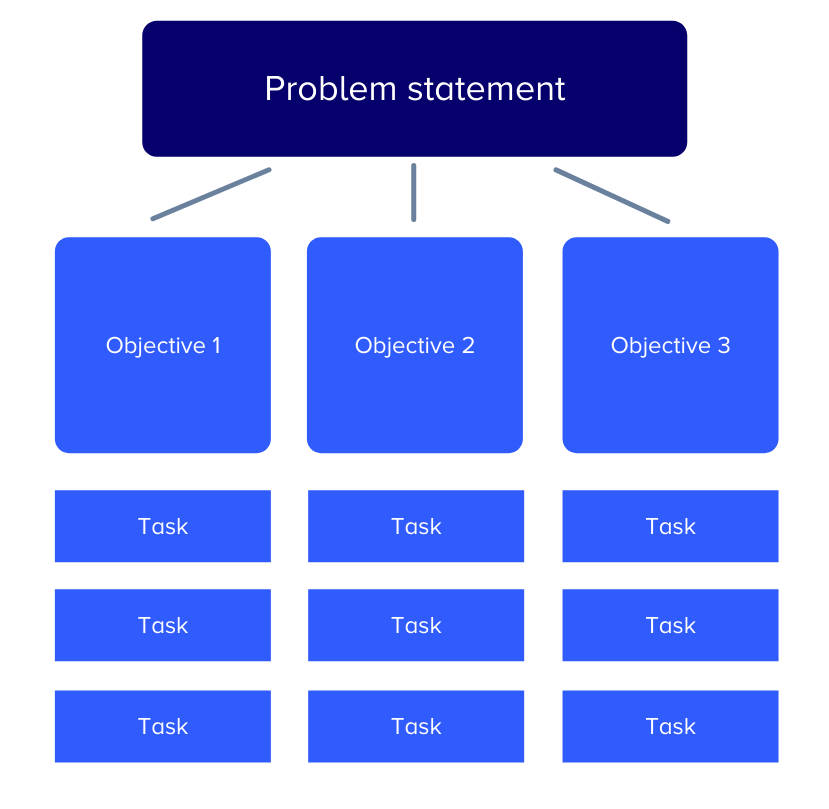
Writing and refining your UX research objectives

While winging it and hoping for the best might work in some life scenarios, this doesn’t apply when it comes to UX research and user feedback. Like most projects, research studies require intensive planning and strategizing early on. While plans can evolve and change as you gather new information, early preparation is an unskippable step. And just like you can’t have UX without UI, a research study isn’t complete with an objective. By having a solid understanding of your study’s purpose, you’ll be able to better stay on track and motivated throughout your development process.
A research objective, also known as a goal or an objective, is a sentence or question that summarizes the purpose of your study or test. In other words, it’s an idea you want to understand deeper by performing research. Objectives should be the driving force behind every task you assign and each question that you ask. These objectives should center on specific features or processes of your product. Think of it this way: the better your objective, the better your feedback will be.
Keeping your objective front and center will help you figure out your UX research deliverables. It will ensure you structure your studies to gain insights into the right set of activities, and figure out the UX research tools that will work best for each stage of product design. It’ll also guide you in which participants to recruit to participate in your research, the tasks you’ll ask them to complete, and what questions to ask.
How do I write a research objective?
Start with a problem statement
As a general rule of thumb, start with a problem instead of a new idea. Unless you're embarking on generative or exploratory research for a brand-new product, your focus should be on solving existing customer issues instead of creating new ones.

Before you write your objective, you need a problem statement, which you can source from your customer support team, negative customer reviews, or feedback from social media. Topic examples might be an unclear return policy, difficulty applying a promo code, or frustrating page navigation. From there, your objective might look like, “How do people go about applying discounts in our checkout process?” or “How do our competitors describe their offerings compared to ours?”
Keep your objective action-oriented and specific
If you need help, you might start drafting your objective by filling in the blanks of “I want to learn ____,” “I want to understand ____,” or “I want to identify ____.”
Many UX researchers agree that the more specific the objectives, the easier it is to write tasks and UX research questions, and the easier it will be to find the answers to those questions through your research. However, your objective doesn’t have to be confined to a single angle; it could have the potential to inspire multiple test directions. For instance, take this research objective: “I want to understand and resolve the barriers customers face when looking for answers about products and services on our website.”
From this one objective, potential study angles could be:
- Content quality: Learn whether the FAQ questions anticipate users’ needs and if the answers are sufficiently detailed and directive.
- FAQ accessibility: Can customers easily find the FAQ section? What access points should we consider?
- FAQ concept test: Is the design approach we’re considering for the proposed redesign understandable? What can we do to optimize it?
As you can see, the above objective can be branched out to address content, usability, and design. For further inspiration, collaborate with the product’s stakeholders. You can start the conversation at a high level by determining what features or processes they want test participants to review, like a navigation menu or website messaging.
Examples of research objectives
New product ideation and validation
- Do people find value in this new product idea?
- I want to learn why customers abandon their carts and their thought process.
- Why is a customer motivated to visit an app?
Resolving customer issues on a live product
- Can users find the information they need?
- What do users think of this section?
- Is the amount of products in this one category appropriate?
- Can users easily navigate to this page?
- How do our competitors describe their offerings compared to us?
- I want to understand and resolve the barriers customers face when seeking answers about products and services on our website.
Solicit feedback from your team(s) and stakeholders
Before you put a stamp of approval on a research objective, ask for feedback from your team and stakeholders. Two researchers could write very different test plans when an objective is unclear or misaligned. For example, one researcher may home in on design while another focuses on usability. Meanwhile, one may keep their objective more broad while another writes one that’s more detailed. And while the findings from any of these studies would be insightful, they might not match up with what the team actually needs to learn.
You can write a UX research report to present your findings. You can also suggest a demonstration or walk-through of the feature or process in question; more detailed concerns may come to light as everyone goes through the experience together and you get the chance to probe about different aspects.
So, to summarize:
- Start the process with a problem statement.
- Loop in stakeholders early if applicable.
- Brainstorm your objective and ensure your team is aligned.
When should I write a research objective—and how should they be prioritized?
Writing and refining your research objective should come after you have a clear problem statement and before you decide on a research method and test plan to execute your study. You can also use targeted questions to prioritize your research.
After you’ve written a rough draft of your research objective, the ink might not even be dry when stakeholders could get involved by offering you an abundance of objectives to prioritize. To figure out what to tackle first, ask your stakeholders to rank their needs. This step could happen via email or in a meeting, but another method could be to list out all of the possible objectives in a Google form and have everyone rearrange the list into their ideal order.
If you’re having trouble getting the stakeholders to articulate their priorities further, try reviewing any available analytics data to pinpoint areas of concern, like pages with an unusually high bounce rate or average time on page. Opting for the objective tied to a KPI—from increasing website conversions to driving more daily active users in your SaaS product—will help you maximize your research impact on business results. This provides the added benefit of demonstrating the ROI of your research on tangible, company-wide objectives.
How many research objectives do I need?
Your objectives—and the number of objectives you should include—will depend on the stage of product development you’re in. Each stage of development has different research objectives and questions that need answering. Once you’ve decided on a problem statement, you could either have one or multiple research objectives that tie back to that statement.
Typically, you’ll want to select one to three objectives; the less you have, the more manageable your test (and timeline) will be. You might choose one general objective and a few more specific objectives.
Get inspiration from the UserTesting template library
If you’re stuck and need some guidance to get the wheels turning, the UserTesting template library is a great place to start for common questions you need answers to or inspiration for your research objective.
If your objective focuses on a mobile app experience:
- Mobile app comparison: Compare two mobile app experiences side-by-side.
- Mobile app evaluation: Assess critical app characteristics such as appearance, ease of use, and trust.
- App store feedback: With the help of human insight, ensure your app store listing resonates with your target customers.
If your objective centers on the web experience:
- Website conversions: Gather insights about what motivates your customers to take action on a website.
- Website comparison: Compare experiences side-by-side to understand what people prefer–and why.
- Landing page conversions: Optimize conversions with insights about what motivates your customers.
- Website evaluation: Assess critical website characteristics such as appearance, ease of use, and trust.
If your objective is improving an ecommerce product:
- Social commerce: Get ahead of messaging, content, and expectations of the social buying experience.
- Black Friday ecommerce: Get your ecommerce experiences ready for the holiday rush.
- Ecommerce and shopping cart experience: Leverage human insight to improve your ecommerce experience year-round.
If your objective is validating early concepts or decisions:
- De-risking product decisions: Reduce risk by testing with your target audience throughout development.
- Value proposition validation: Test your value proposition with insights from your target customer.
- Concept validation and testing: Get candid feedback or validation to help evaluate a new concept or idea.

UX resource collection
Explore UX best practices, expert advice, user research templates, and more.





